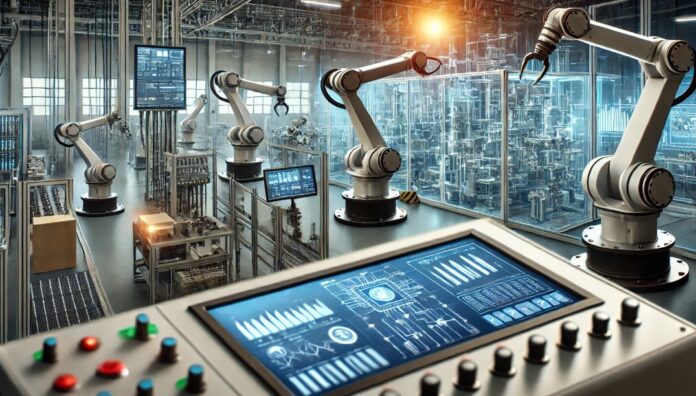In today’s rapidly evolving industrial landscape, businesses must embrace automation to stay competitive. Whether in manufacturing, energy, or infrastructure, automation plays a crucial role in enhancing efficiency, reducing operational costs, and improving overall productivity.
Among the most impactful advancements in this field are General Automation and PLC Systems. These technologies streamline operations, reduce human error, and create highly responsive systems capable of handling complex industrial processes. This article explores their benefits, applications, and how they are shaping the future of industry.
What is General Automation?
General automation refers to the use of technology to perform tasks with minimal human intervention. This encompasses a wide range of automated processes across different industries, from robotic assembly lines to smart manufacturing systems that use artificial intelligence (AI) and the Internet of Things (IoT).
Automation can be implemented in various forms, including:
- Industrial robots that handle tasks like assembly, welding, and packaging.
- Automated conveyor systems that enhance material handling in logistics.
- AI-powered decision-making for real-time optimization of production lines.
- Smart monitoring and control systems that ensure consistent quality and performance.
By integrating these technologies, companies can increase productivity, reduce waste, and improve workplace safety.
The Role of PLC Systems in Industrial Automation
A critical component of industrial automation is the PLC Systems (Programmable Logic Controllers). PLCs are industrial computers designed to automate electromechanical processes, offering precise control over machinery and production lines.
How PLC Systems Work
PLCs operate by receiving input signals from sensors and switches, processing the data, and triggering output responses such as activating motors, opening valves, or adjusting conveyor speeds. These systems are programmed using specialized software, allowing for flexibility and customization according to specific operational needs.
Key Advantages of PLC Systems
- High Reliability – PLCs are built to withstand harsh industrial environments, including extreme temperatures, dust, and vibrations.
- Real-Time Processing – They provide instantaneous control over industrial operations, ensuring smooth and efficient workflows.
- Easy Troubleshooting and Maintenance – PLCs have diagnostic features that help detect and resolve system faults quickly.
- Scalability – These systems can be expanded and modified as business needs evolve, making them ideal for growing industries.
Applications of General Automation and PLC Systems
1. Manufacturing and Production
Automation is revolutionizing the manufacturing sector by reducing human error, increasing production speed, and improving product consistency. Automated assembly lines, robotic arms, and AI-powered quality control systems are common applications.
2. Energy and Utilities
Power plants, water treatment facilities, and oil refineries rely on PLC-controlled automation to regulate flow rates, temperature levels, and system safety protocols. Smart automation ensures energy efficiency and operational reliability.
3. Logistics and Warehousing
Automated conveyor belts, robotic picking systems, and warehouse management software optimize supply chain operations. This reduces delays and improves inventory tracking accuracy.
4. Automotive Industry
From precision welding robots to automated painting systems, PLC-controlled machinery ensures high-quality automotive manufacturing with minimal defects.
5. Smart Buildings and Infrastructure
General automation is increasingly being used in smart buildings to control lighting, heating, ventilation, and air conditioning (HVAC) systems. Automated security and fire detection systems also enhance safety and efficiency.
Benefits of Adopting General Automation and PLC Systems
1. Increased Efficiency and Productivity
Automated processes operate continuously without fatigue, reducing downtime and maximizing output.
2. Cost Reduction
By minimizing human error and optimizing resource usage, automation significantly lowers operational costs.
3. Enhanced Safety
Automation reduces the need for human involvement in hazardous tasks, improving workplace safety.
4. Improved Quality and Precision
Automated systems ensure consistent quality control, reducing defects and waste in production.
5. Greater Flexibility
Modern PLCs and automation systems allow for easy reprogramming and adaptation to new production demands, making businesses more agile.
The Future of Automation: What’s Next?
With rapid advancements in AI, machine learning, and IoT, automation is expected to become even more intelligent and adaptive. Future trends in industrial automation include:
- AI-driven predictive maintenance to prevent equipment failures before they happen.
- Collaborative robots (cobots) working alongside human employees for increased efficiency.
- 5G-enabled automation allowing for faster and more reliable communication between industrial devices.
- Sustainable automation focusing on energy efficiency and environmentally friendly practices.
As automation continues to evolve, businesses that invest in cutting-edge automation technologies like General Automation and PLC Systems will have a competitive edge in the market.
Conclusion
Embracing automation is no longer a choice—it’s a necessity for industries aiming to boost efficiency, cut costs, and improve safety. General automation streamlines operations across various sectors, while PLC systems provide precise and reliable control over machinery and industrial processes.
As the industrial world moves towards smarter, AI-powered automation, businesses that leverage these technologies will thrive in an increasingly automated future.
If you’re looking to enhance your operations with cutting-edge automation solutions, explore General Automation and PLC Systems today!


